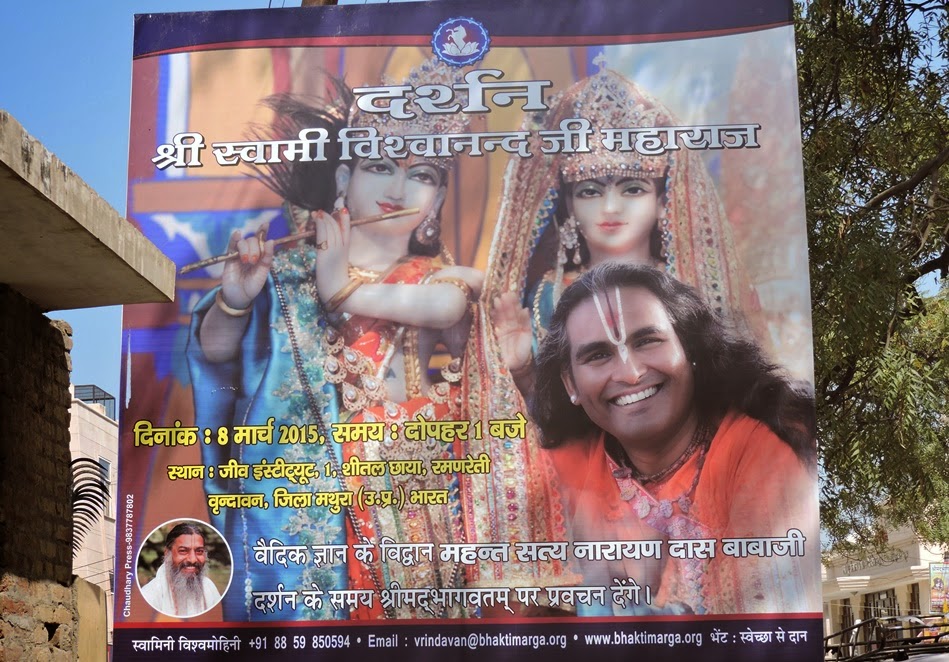Renunciation and Institutional Religion
Last night before going to bed, I spent some time reading the Sampradaya Sun, which is currently rehashing in great detail the scandals surrounding Kirtanananda and New Vrindavan. Besides the horrific big picture, there were many little details that burdened my heart, and not just those of the brutal murders.
One was the spectacle shown in two YouTube videos (linked in Navadvipacandra's article) where IRM activists bait Iskcon devotees at two different Rathayatra parades. They get the inevitable rise out of their prey, including, to his great shame, Ravindra Svarupa.
Then there is the picture of Srigalim, whose ugly history of child abuse is one of the most putrid in the terrifying squirming stench of human misery that is the Iskcon child abuse scandal. Apparently he is now working his own scam charity to the tune of 100,000 tax free dollars a year, building an ashram and offering spiritual guidance while advertising publicly for the soulmate who, sadly, still eludes him.
Then there are those “enemies” of New Vrindavan, the lawyer David Gold and his client and Zen teacher Richard Rose, who in their simplicity and steadfastness come across as likably human and even possessed of authentic wisdom. For example,
It was troubling reading and I slept poorly afterward. It gave me pause to rethink what I had posted earlier in the day. When I and others like Advaita left Iskcon, it was in part due to a feeling that there was insufficient internalization going on. Even though a regime of sixteen rounds a day was supposedly in effect, the emphasis everywhere was on externals. The spiritual path is a razor’s edge, so goes the well-known saying of the Katha Upanishad, and it certainly seemed to us that there was a lot of bloody slippage going on.
The other day I made a reference to the Bhagavata verse (7.13.8) quoted in Bhakti-rasamrita-sindhu (1.2.113)—
na ziSyAn anubadhnIta granthAn naivAbhyased bahUn |
na vyAkhyAm upayuJjIta nArambhAn Arabhet kvacit ||
Saraswati Thakur always turned this statement around by making it seem that a devotee takes the risk of ruining his own devotional advancement in order to benefit others. "One should be ready to go to hell to benefit others." There is certainly a force in community: different people's talents complement others', and working together gives individual strength and builds faith. Again, one may persuasively argue that if the goal is to fight the ego, a communal environment obliges one to "surrender" his ego.
For Rocana and the other reformers, the trouble all comes of not following the commands of Prabhupada. I have great respect for Rocana, who believes that proper management techniques could save Iskcon, rather than thinking that there is something in the institution itself that attracts the kind of dissimulation and falseness happening, again and again.
In my class the other day, I was talking about the geography of Bengal and the role that it played in its history. Buddhism probably came into Bengal at the same time or even earlier than Vedism. But we see that Vedism or Brahmanism or Hinduism made inroads in Bengal despite the strong presence of Buddhism there. Even the Pal kings, the last great royal patrons of Buddhism in India, still gave support to brahmins. This is probably in great part because Buddhism, being a religion with a primarily ascetic or world-renouncing ethic, was unable to sustain itself socially without having a functioning worldly religion against which to differentiate itself. A similar situation arose in China, where Buddhism coexisted with Taoism and Confucianism without really even trying to supplant them. The relationship was one of tension.
Dasgupta points out that one of the characteristics of Tantra, whether manifest in the Buddhist or the Hindu context, is to act as a kind of anti-authoritarian movement. Ironically, the Vajrayan and the Sahajayan rebelled against even the ritualism and formalism that entered into the Buddhist tantra. This spirit is perhaps best exemplified in later times by the writings of Kabir and the Sants, who are in a direct spiritual line from the Buddhist Siddhas and the Nath yogis, all of whom criticize the religious establishments in the midst of which they were living.
I guess what I am saying is that it is the natural stance of some to be conservative, and of others to be revolutionary; of some to be more conscious of the needs of the group, and of others to be individualistic. Since flaws, or dangers, are associated with each of these attitudes to spirituality, there will always be the need for the checks and balances that come from the other disposition. A social approach to religion will always need to be tempered by those who seek genuine mystical experience, the most individual posture that one can attain. On the other hand, all mystical experience must result in value for society in general and form the basis for human community. A perfect balance is impossible, for a society of elevated mystics cannot exist. However, there is perhaps a certain level of limited, temporary success that is achievable.
One was the spectacle shown in two YouTube videos (linked in Navadvipacandra's article) where IRM activists bait Iskcon devotees at two different Rathayatra parades. They get the inevitable rise out of their prey, including, to his great shame, Ravindra Svarupa.
Then there is the picture of Srigalim, whose ugly history of child abuse is one of the most putrid in the terrifying squirming stench of human misery that is the Iskcon child abuse scandal. Apparently he is now working his own scam charity to the tune of 100,000 tax free dollars a year, building an ashram and offering spiritual guidance while advertising publicly for the soulmate who, sadly, still eludes him.
Then there are those “enemies” of New Vrindavan, the lawyer David Gold and his client and Zen teacher Richard Rose, who in their simplicity and steadfastness come across as likably human and even possessed of authentic wisdom. For example,
"There's two kinds of magic," Rose said. "White and black. White magic is what I call between-ness, and I recommend everyone learn how to use it. But there's black magic, too, and the Krishnites are dealing in it, whether they know it or not."I have to say, though, that I feel ambivalent about crusaders like Rocana and Navadvipacandra, not that I don't appreciate what they are doing. They remind me a bit of the IRM hecklers...
"How?"
"By attracting certain types of entities. Different kinds of entities are attracted to different kinds of human acts. Entities gain energy from our actions--our expenditures of energy. Sex is the primary release of energy the entities feed on, and some feed on particular kinds of perversions. Keith Ham and his outfit are feeding the pederastic entities. Naturally these entities want to protect the Krishnites so they can continue to get fed."
Rose also went on to say, however, that these entities would eventually turn on the Krishnas and bring about their downfall. This, he said, was the price one inevitably paid for dealing with the dark side. I took some solace in thinking that the Krishnas might someday be on the short end of things, but in the meantime I was not comforted by the thought that "pederastic entities" were interfering with my personal life. .After the Absolute
It was troubling reading and I slept poorly afterward. It gave me pause to rethink what I had posted earlier in the day. When I and others like Advaita left Iskcon, it was in part due to a feeling that there was insufficient internalization going on. Even though a regime of sixteen rounds a day was supposedly in effect, the emphasis everywhere was on externals. The spiritual path is a razor’s edge, so goes the well-known saying of the Katha Upanishad, and it certainly seemed to us that there was a lot of bloody slippage going on.
The other day I made a reference to the Bhagavata verse (7.13.8) quoted in Bhakti-rasamrita-sindhu (1.2.113)—
na vyAkhyAm upayuJjIta nArambhAn Arabhet kvacit ||
[A sannyasi] should not make disciples. He should not study too many books. He should not make a living from explaining the scriptures, nor should he ever begin any undertaking.Sri Jiva says that this injunction, being as it is included in the general rules for devotional service, does not apply to sannyasis alone, but to all devotees, for they too follow the nivRtti-mArga.
Saraswati Thakur always turned this statement around by making it seem that a devotee takes the risk of ruining his own devotional advancement in order to benefit others. "One should be ready to go to hell to benefit others." There is certainly a force in community: different people's talents complement others', and working together gives individual strength and builds faith. Again, one may persuasively argue that if the goal is to fight the ego, a communal environment obliges one to "surrender" his ego.
For Rocana and the other reformers, the trouble all comes of not following the commands of Prabhupada. I have great respect for Rocana, who believes that proper management techniques could save Iskcon, rather than thinking that there is something in the institution itself that attracts the kind of dissimulation and falseness happening, again and again.
In my class the other day, I was talking about the geography of Bengal and the role that it played in its history. Buddhism probably came into Bengal at the same time or even earlier than Vedism. But we see that Vedism or Brahmanism or Hinduism made inroads in Bengal despite the strong presence of Buddhism there. Even the Pal kings, the last great royal patrons of Buddhism in India, still gave support to brahmins. This is probably in great part because Buddhism, being a religion with a primarily ascetic or world-renouncing ethic, was unable to sustain itself socially without having a functioning worldly religion against which to differentiate itself. A similar situation arose in China, where Buddhism coexisted with Taoism and Confucianism without really even trying to supplant them. The relationship was one of tension.
Dasgupta points out that one of the characteristics of Tantra, whether manifest in the Buddhist or the Hindu context, is to act as a kind of anti-authoritarian movement. Ironically, the Vajrayan and the Sahajayan rebelled against even the ritualism and formalism that entered into the Buddhist tantra. This spirit is perhaps best exemplified in later times by the writings of Kabir and the Sants, who are in a direct spiritual line from the Buddhist Siddhas and the Nath yogis, all of whom criticize the religious establishments in the midst of which they were living.
I guess what I am saying is that it is the natural stance of some to be conservative, and of others to be revolutionary; of some to be more conscious of the needs of the group, and of others to be individualistic. Since flaws, or dangers, are associated with each of these attitudes to spirituality, there will always be the need for the checks and balances that come from the other disposition. A social approach to religion will always need to be tempered by those who seek genuine mystical experience, the most individual posture that one can attain. On the other hand, all mystical experience must result in value for society in general and form the basis for human community. A perfect balance is impossible, for a society of elevated mystics cannot exist. However, there is perhaps a certain level of limited, temporary success that is achievable.



Comments